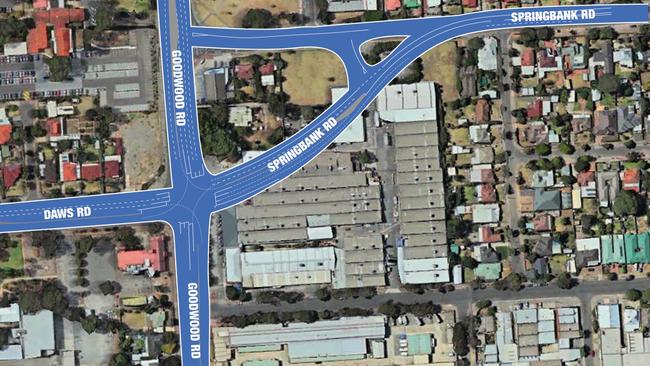Dog-leg “dog’s breakfast” intersection on Goodwood Rd to be abolished
ONE of Adelaide’s most disruptive dogleg intersections will cease to exist from next year, to be replaced by a new design by the Transport Department.

SA News
Don't miss out on the headlines from SA News. Followed categories will be added to My News.
- Adelaide’s 10 most dangerous intersections revealed
- Call to nominate SA’s worst roads and intersections
- AAMI reveals worst parts of Adelaide for road crashes
ONE of Adelaide’s most disruptive dogleg intersections will cease to exist from next year, to be replaced by a new design by the Transport Department.
The Advertiser can today reveal plans for the intersection of Goodwood, Springbank and Daws roads, which will be joined up in one traffic-light controlled intersection.
The “realignment” project, which is yet to be finally costed, will put an end to the dogleg delay for east-west traffic on Daws and Springbank roads. Last year, costs for the project were estimated at $30 million.
Currently, vehicles must stop once to enter Goodwood Rd and then again to exit. The realignment will allow motorists to move directly across Goodwood Rd through one set of traffic lights.
Transport Minister Stephen Mullighan said the end of the two staggered T-junctions would streamline traffic flow, reduce congestion and improve safety.
“Extensive public consultation will be undertaken including doorknocking, one-on-one meetings, mail-outs, phone and email inquiry lines and direct contact with stakeholders and interest groups,” he said. Mr Mullighan said the design may change after public consultation.
The current redesign will significantly disrupt the Bedford site on the southeast side of the intersection. The group is working with the Government on the project.
Transport Department illustrations show about a quarter of the Bedford site built over as Springbank Rd is diverted to the south.
The organisation is one of SA’s oldest charities, providing employment and training opportunities for disabled people for more than 120 years.
Bedford chief executive Sally Powell said the organisation was moving into formal negotiations with the Government on the design.
She said Bedford had already indicated it had outgrown its site and was happy to move, with the right compensation to be determined.
The organisation moved to the site in 1949 and was keen to minimise the disruption to its clients if it moved, she said.
“We have been working with the State Government for some time and the works have converged with us outgrowing the site quite nicely,’’ she said.
State Government figures show on average more than 60,000 vehicles a day travel through the two intersections, with 21 crashes resulting in 24 casualties between 2012 and 2016.
Elected members from across the political divide have called for an end to the traffic chaos at the intersections.


